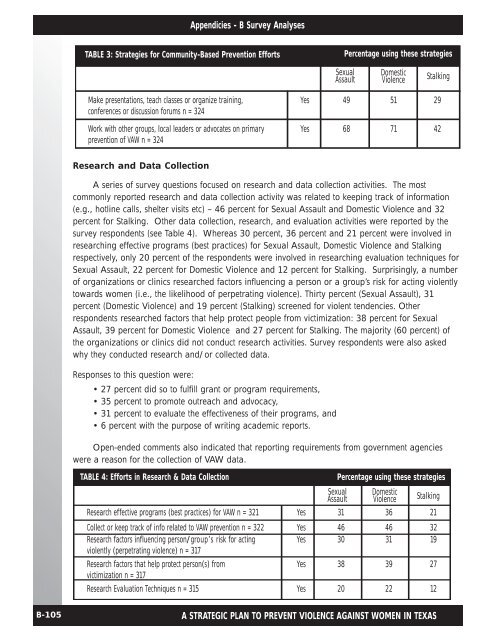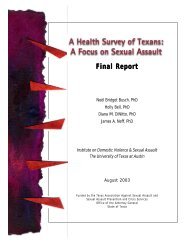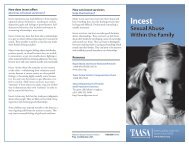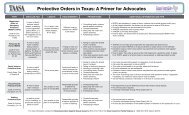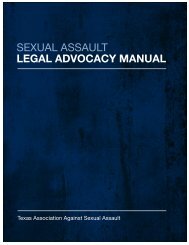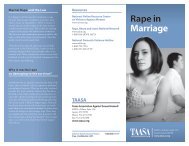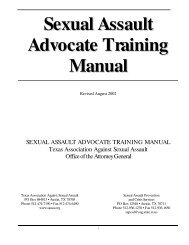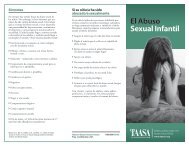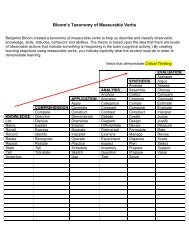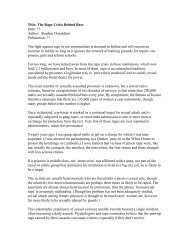TDH Booklet4 - Texas Association Against Sexual Assault
TDH Booklet4 - Texas Association Against Sexual Assault
TDH Booklet4 - Texas Association Against Sexual Assault
Create successful ePaper yourself
Turn your PDF publications into a flip-book with our unique Google optimized e-Paper software.
Appendicies - B Survey Analyses<br />
TABLE 3: Strategies for Community-Based Prevention Efforts<br />
Percentage using these strategies<br />
<strong>Sexual</strong><br />
<strong>Assault</strong><br />
Domestic<br />
Violence<br />
Stalking<br />
Make presentations, teach classes or organize training, Yes 49 51 29<br />
conferences or discussion forums n = 324<br />
Work with other groups, local leaders or advocates on primary Yes 68 71 42<br />
prevention of VAW n = 324<br />
Research and Data Collection<br />
A series of survey questions focused on research and data collection activities. The most<br />
commonly reported research and data collection activity was related to keeping track of information<br />
(e.g., hotline calls, shelter visits etc) – 46 percent for <strong>Sexual</strong> <strong>Assault</strong> and Domestic Violence and 32<br />
percent for Stalking. Other data collection, research, and evaluation activities were reported by the<br />
survey respondents (see Table 4). Whereas 30 percent, 36 percent and 21 percent were involved in<br />
researching effective programs (best practices) for <strong>Sexual</strong> <strong>Assault</strong>, Domestic Violence and Stalking<br />
respectively, only 20 percent of the respondents were involved in researching evaluation techniques for<br />
<strong>Sexual</strong> <strong>Assault</strong>, 22 percent for Domestic Violence and 12 percent for Stalking. Surprisingly, a number<br />
of organizations or clinics researched factors influencing a person or a group’s risk for acting violently<br />
towards women (i.e., the likelihood of perpetrating violence). Thirty percent (<strong>Sexual</strong> <strong>Assault</strong>), 31<br />
percent (Domestic Violence) and 19 percent (Stalking) screened for violent tendencies. Other<br />
respondents researched factors that help protect people from victimization: 38 percent for <strong>Sexual</strong><br />
<strong>Assault</strong>, 39 percent for Domestic Violence and 27 percent for Stalking. The majority (60 percent) of<br />
the organizations or clinics did not conduct research activities. Survey respondents were also asked<br />
why they conducted research and/or collected data.<br />
Responses to this question were:<br />
• 27 percent did so to fulfill grant or program requirements,<br />
• 35 percent to promote outreach and advocacy,<br />
• 31 percent to evaluate the effectiveness of their programs, and<br />
• 6 percent with the purpose of writing academic reports.<br />
Open-ended comments also indicated that reporting requirements from government agencies<br />
were a reason for the collection of VAW data.<br />
TABLE 4: Efforts in Research & Data Collection<br />
Percentage using these strategies<br />
<strong>Sexual</strong><br />
<strong>Assault</strong><br />
Domestic<br />
Violence<br />
Stalking<br />
Research effective programs (best practices) for VAW n = 321 Yes 31 36 21<br />
Collect or keep track of info related to VAW prevention n = 322 Yes 46 46 32<br />
Research factors influencing person/group’s risk for acting Yes 30 31 19<br />
violently (perpetrating violence) n = 317<br />
Research factors that help protect person(s) from Yes 38 39 27<br />
victimization n = 317<br />
Research Evaluation Techniques n = 315 Yes 20 22 12<br />
B-105 A STRATEGIC PLAN TO PREVENT VIOLENCE AGAINST WOMEN IN TEXAS


